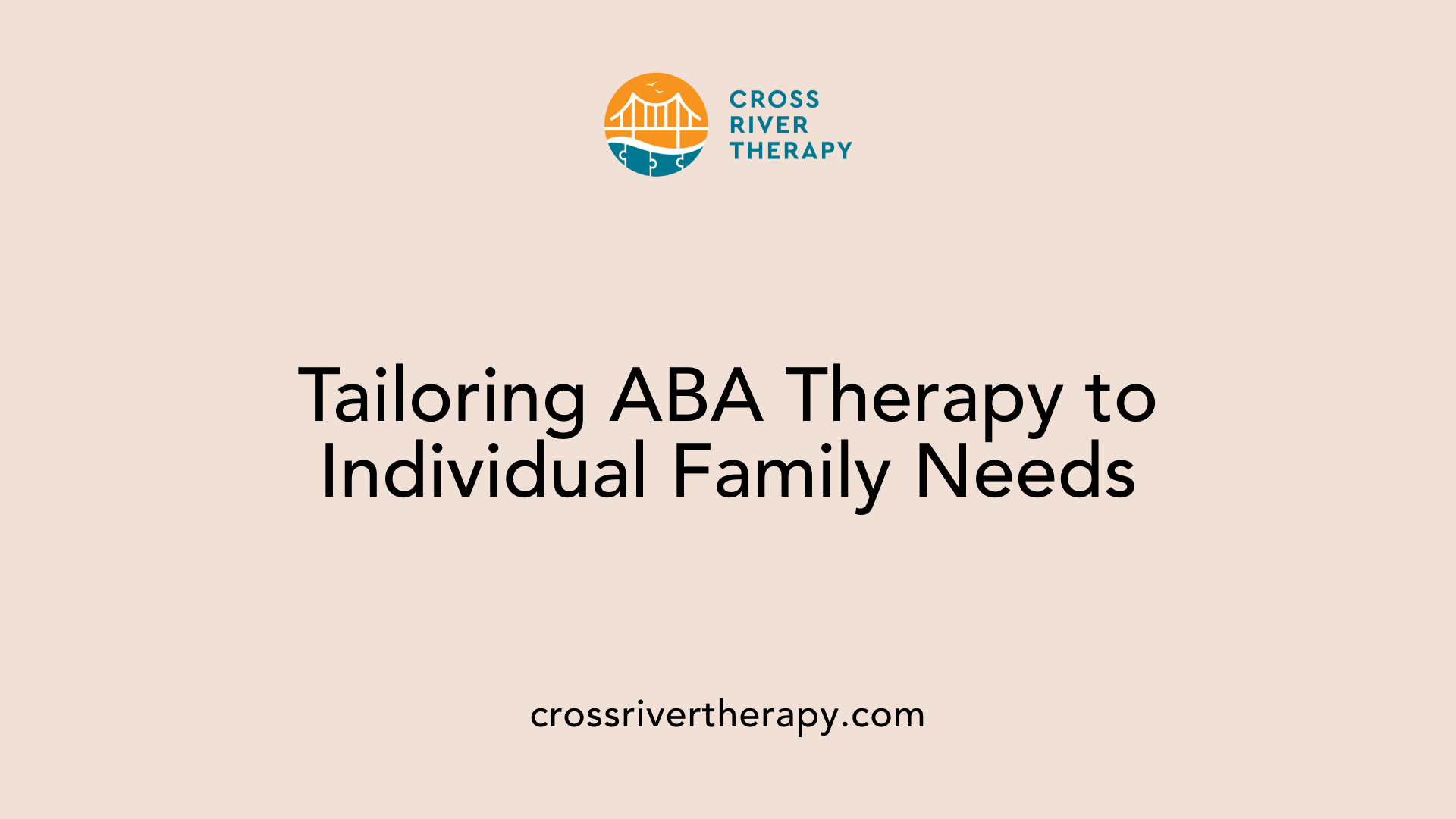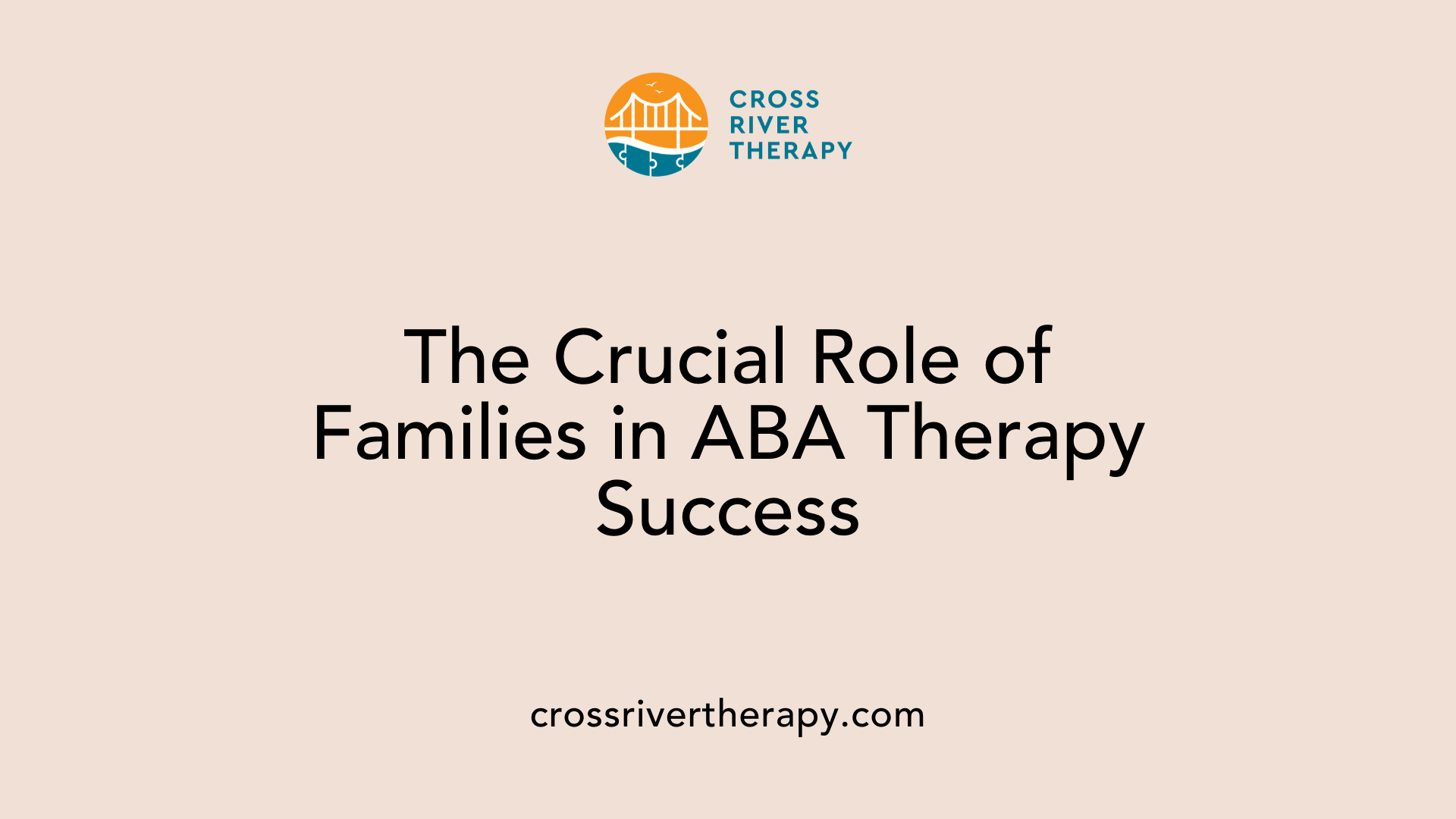How At-Home ABA Therapy Programs Are Tailored to Each Family
Personalizing ABA Therapy for Home: A Family-Centric Approach
Introduction: The Home Advantage
Applied Behavior Analysis (ABA) therapy is a well-recognized approach for supporting children with autism. While traditionally practiced in clinical settings, the at-home delivery of ABA therapy has shown promising benefits. This article explores how these programs are specifically tailored to cater to the unique needs of families, enhancing the effectiveness of interventions and promoting an integrative therapeutic experience.
Understanding At-Home ABA Therapy

Overview of ABA therapy
ABA therapy, or Applied Behavior Analysis, is a widely recognized method for treating children with autism, emphasizing evidence-based strategies to teach essential skills. When delivered in the child's home, the therapy is tailored to meet individual needs, focusing on crucial life skills such as communication, self-care, and social interactions.
During initial sessions, therapists conduct thorough assessments to understand each child’s unique strengths and challenges. Subsequently, they develop individualized treatment plans that align with family dynamics and daily routines. The regular engagement of family members in the process enhances the therapy, making it more effective and relatable for the child.
Home environment benefits
In-home ABA therapy offers significant advantages by utilizing the child’s familiar surroundings. This comfort reduces anxiety and encourages active participation, allowing children to engage in learning without the stress of new environments.
To maximize the benefits of in-home therapy:
- Create a distraction-free space: An organized area helps maintain focus during sessions.
- Involve family members: Parents and siblings can actively participate, reinforcing skills through daily interactions.
- Flexibility in scheduling: Therapists can adjust session times to accommodate family routines, ensuring less disruption to everyday life.
In this personalized setting, therapists can directly observe behaviors and provide context-sensitive strategies that address specific challenges, ultimately enhancing skill retention and promoting meaningful progress in the child’s development.
The Customization Process of ABA Therapy

How is ABA therapy customized for individual families?
ABA therapy is expertly tailored to meet the specific needs of individual families, guided by the seven dimensions of Applied Behavior Analysis. These dimensions highlight the importance of focusing on socially significant behaviors that enhance the quality of life for children with autism.
Practitioners begin by conducting detailed assessments to identify the unique strengths, challenges, and interests of each child. This assessment leads to personalized treatment goals, such as improving communication skills, self-care, or social interactions, relevant to the child’s daily life at home.
Each therapy plan is crafted to ensure that the interventions are:
- Applied: Targeting real-life behaviors important to the family.
- Behavioral: Focused on observable behaviors for clear assessment.
- Analytic: Data-driven, allowing for adjustments based on progress.
- Technological: Well-documented procedures for consistency among therapists.
- Conceptually Systematic: Based on established ABA principles.
- Effective: Demonstrating measurable improvement in targeted behaviors.
- Generality: Promoting the application of skills across different situations.
Through a collaborative approach involving family members, therapists ensure that strategies learned can be reinforced in everyday contexts, fostering a cohesive learning environment and enhancing overall outcomes.
Importance of Family Involvement

What role do parents play during in-home ABA therapy?
Parents play a crucial role during in-home ABA therapy by establishing a structured and supportive environment that reinforces learning. Their involvement helps create a sense of safety and comfort for the child, enhancing engagement and receptiveness to therapeutic techniques.
Creating Consistent Routines
- Parents are encouraged to establish consistent routines, which are vital in reinforcing what is taught during therapy.
- Utilizing visual supports, such as picture cards and timers, can help manage expectations and communicate needs effectively.
Generalizing Skills into Daily Life
- Families are instrumental in generalizing skills from therapy into real-life situations. This fosters independence and reinforces learning, as children practice skills like communication and self-care during everyday activities.
- Parents must focus on positive reinforcement strategies, especially when addressing undesirable behaviors, creating a supportive feedback loop for their child.
Collaborating with Therapists
- Actively collaborating with therapists allows parents to set appropriate goals tailored to their child’s needs.
- Parents observe sessions and collect data, facilitating tracking of progress and adapting strategies as necessary.
Emotional Support and Advocacy
- Emotional support from parents keeps the child motivated and engaged, crucial for consistent progress.
- Additionally, parents serve as advocates by understanding ABA principles, enhancing their ability to secure appropriate services in educational and community settings.
Ongoing support and compassion for personal challenges are essential for parents navigating the therapy process, making their role foundational in home-based ABA therapy.
Creating a Conducive Home Environment for ABA Therapy

Setting up a therapy space
Creating an ideal space for ABA therapy within the home is essential for effective learning. Start by designating a specific area where therapy sessions will take place. This space should promote comfort while being optimized for focus.
Key elements to consider when setting up include:
- Clean and Organized: Maintain a clutter-free area that can reduce anxiety and enhance the child’s concentration.
- Comfortable Seating: Provide appropriate seating arrangements for both the child and the therapist, allowing them to engage comfortably.
- Accessible Materials: Ensure that any materials or tools required for therapy are within easy reach to facilitate smooth sessions.
Reducing distractions
To help improve the learning experience, it’s important to minimize potential distractions during therapy sessions. Strategies to achieve this include:
- Quiet Environment: Choose a location away from high-traffic areas of the home to limit noise and interruptions.
- Controlled Visual Stimulation: Avoid bright colors or busy decorations that may detract the child’s attention from the tasks at hand.
- Time Management: Schedule therapy sessions at times when the child is most alert and receptive, ensuring optimal participation.
By fostering an environment conducive to learning, in-home therapy can become more effective, paving the way for meaningful skill development.
The Role of Routine and Flexibility
Integrating therapy into daily life
In-home ABA therapy excels at weaving treatment into everyday routines, allowing children to learn within the comfort of their familiar environment. This approach enhances skill generalization, as skills are practiced during common activities like mealtime and playtime. For example, a child might engage in communication exercises while setting the table or practice self-care skills during bath time.
By focusing on real-world challenges and behaviors, therapists can tailor sessions to meet the child's individual needs while also addressing issues that arise in their daily life. This ensures that the therapy aligns with the family's natural flow, making it easier for everyone to participate and reinforce learned skills consistently.
Flexible scheduling benefits
One of the significant advantages of in-home ABA therapy is the flexibility in scheduling sessions. This adaptability is especially beneficial for families with busy lifestyles. With in-home treatment, parents can arrange appointments around their children's existing routines, minimizing disruptions and maximizing engagement.
Additionally, flexible scheduling helps maintain continuity of care, as therapists can monitor progress in the environment where the child exhibits specific behaviors. This ongoing support not only enhances the effectiveness of the therapy but also fosters a supportive atmosphere that encourages parents to stay involved in their child's development.
Enhancing Engagement and Learning
Child Engagement Strategies
To optimize learning in in-home ABA therapy, therapists utilize various engagement strategies tailored to the child's interests and daily life. By embedding therapeutic activities into routine tasks like mealtime and playtime, children can practice essential skills in familiar settings. This context-based approach encourages active participation, making learning feel natural rather than forced.
Additionally, collaboration with family members allows therapists to adapt strategies based on immediate feedback. When parents and siblings are involved in sessions, not only do they reinforce learned skills, but they also contribute to a more dynamic and engaging environment.
Skill Retention Techniques
Skill retention is fostered through continual practice in real-life situations. Home-based therapy allows children to generalize learned skills to their daily activities, increasing familiarity and comfort. For example, tasks such as toilet training or self-care routines can be practiced during therapy, ensuring that the child can replicate these skills outside of sessions.
Moreover, therapists collect data and conduct regular assessments to monitor progress, allowing for timely adjustments to treatment plans. This adaptable approach boosts effectiveness and helps maintain engagement, as children can see their improvements in meaningful contexts. The result is a comprehensive and supportive learning experience that enhances not only the child's skillset but also their confidence and independence.
The Comprehensive Benefits of At-Home ABA Therapy
Familiar Settings Advantages
In-home ABA therapy presents the unique advantage of familiar surroundings, which greatly helps reduce anxiety for children with autism. By conducting sessions in the comfort of their own home, children experience a sense of security that enhances their learning potential. This familiar environment allows therapists to focus on skills relevant to the child's daily life, such as communication and self-care, during typical family activities like mealtime and playtime.
Additionally, the active involvement of family members encourages reinforcement of skills. Parents and siblings can directly participate in the learning process, providing continuity and support. This involvement not only enriches the therapeutic experience but also strengthens family dynamics by fostering collaboration and shared goals.
Cost-Effectiveness
Home-based ABA therapy can often be more cost-effective than traditional clinic-based options. It minimizes travel expenses associated with attending therapy sessions, making it financially appealing for many families. Also, the personalized approach may lead to fewer overall therapy hours needed, as children are typically more engaged when receiving therapy in a familiar context.
Overall, this tailored method promotes development in real-life situations, maximizing the potential for meaningful progress while contributing to enhanced quality of life for both the child and the family.
Collaboration and Consistency Across Care Settings

Coordination with Other Professionals
Home-based ABA therapy frequently involves collaboration with other professionals involved in the child’s care. This includes educators, speech and language therapists, and occupational therapists. By working together, these specialists can develop cohesive strategies that support the child across various settings, ensuring that the interventions are consistent and applicable in multiple environments.
This holistic approach can lead to more effective outcomes, as care strategies are harmonized, taking into account the child’s strengths and challenges across all contexts. For instance, when a child's speech therapist and ABA therapist share insights, they can create a unified plan that simultaneously promotes communication skills and social interactions during therapy and at home.
Unified Care Strategies
In-home ABA therapy emphasizes the development of unified care strategies that extend beyond the therapy sessions. Parents become essential team members, learning to implement techniques in daily life. This active involvement allows for immediate reinforcement of skills and behaviors practiced during in-home sessions, making the experience more meaningful for the child.
Moreover, effective communication among all caregivers ensures that interventions remain consistent, which is crucial for skill retention and practical application. With family members equipped with strategies and insights, they can provide real-time support, further enhancing the child’s learning experience and promoting long-term developmental goals.
Thus, the collaborative nature of home-based ABA therapy fosters an integrated approach to care, enhances family dynamics, and yields significant improvements in the child's quality of life.
Future of ABA Therapy: Home-Centric Models
Evolving Therapy Practices
The landscape of Applied Behavior Analysis (ABA) therapy is shifting toward more personalized, home-based approaches. As research underscores the effectiveness of in-home sessions, there is a growing recognition of the importance of conducting therapy within the familiar environment of the child. This model allows for the direct observation of behaviors and challenges as they occur naturally, enabling therapists to create customized interventions based on real-world contexts.
In-home therapy provides flexibility, allowing families to schedule sessions that fit their routines while reducing stress associated with travel. The integration of therapy into daily life means that interventions can align closely with the child's everyday activities, from mealtime to playtime, thereby enhancing the generalization of skills.
Long-Term Benefits
The benefits of home-based ABA therapy extend beyond immediate skill acquisition. Families involved in the therapy process contribute significantly to reinforcing learned behaviors, thus ensuring consistency.
- Comfort and Security: The familiar setting reduces anxiety, promoting engagement and motivation for children attending therapy.
- Enhanced Family Dynamics: Active participation encourages emotional support and collaboration among family members.
- Cost-Effectiveness: By minimizing travel expenses and potentially reducing total therapy hours required, families can find financial relief.
- Sustained Progress: A structured yet adaptable approach fosters long-term outcomes as parents are equipped with strategies to support their child's ongoing development.
| Benefit | Description | Impact on the Child |
|---|---|---|
| Comfort and Security | Reduces anxiety during sessions | Increased engagement |
| Enhanced Family Dynamics | Fosters team efforts between parents and therapists | Reinforced behavioral strategies |
| Cost-Effectiveness | Less travel means potential savings | More resources for child activities |
| Sustained Progress | Ensures consistency and longevity in behavior modification efforts | Long-term skill retention |
Conclusion: A Dynamic, Family-Centered Approach
Home-based ABA therapy is an evolving model that emphasizes personalized care, family involvement, and compatibility with daily life routines. It offers a comprehensive approach that addresses the unique needs of each child and their family, promising to enhance both therapeutic outcomes and overall quality of life. As ABA therapy continues to adapt and innovate, its home adaptation sets a precedent for integrative and effective autism support.
References
- 5 Ways to Prepare Your Home for In-Home ABA Therapy | Blog
- Home-Based ABA Therapy: Personalized Benefits for Autism
- Enhance Family Life with ABA Therapy Services
- ABA Therapy at Home vs Clinic-Based: Which Is Right for Your Child?
- Explaining Home-Based ABA Therapy's Effectiveness
- ABA Therapy at Home: Supporting Children with Autism
- The Role of Family in ABA Therapy: Tips for Parents
- Applied Behavior Analysis (ABA) | Autism Speaks
- What are the 7 Dimensions of Applied Behavior Analysis (ABA)
- 7 Dimensions of ABA | Proudstepsaba



